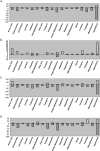Characterization of the Staphylococcus aureus heat shock, cold shock, stringent, and SOS responses and their effects on log-phase mRNA turnover
- PMID: 16980476
- PMCID: PMC1595530
- DOI: 10.1128/JB.00609-06
Characterization of the Staphylococcus aureus heat shock, cold shock, stringent, and SOS responses and their effects on log-phase mRNA turnover
Abstract
Despite its being a leading cause of nosocomal and community-acquired infections, surprisingly little is known about Staphylococcus aureus stress responses. In the current study, Affymetrix S. aureus GeneChips were used to define transcriptome changes in response to cold shock, heat shock, stringent, and SOS response-inducing conditions. Additionally, the RNA turnover properties of each response were measured. Each stress response induced distinct biological processes, subsets of virulence factors, and antibiotic determinants. The results were validated by real-time PCR and stress-mediated changes in antimicrobial agent susceptibility. Collectively, many S. aureus stress-responsive functions are conserved across bacteria, whereas others are unique to the organism. Sets of small stable RNA molecules with no open reading frames were also components of each response. Induction of the stringent, cold shock, and heat shock responses dramatically stabilized most mRNA species. Correlations between mRNA turnover properties and transcript titers suggest that S. aureus stress response-dependent alterations in transcript abundances can, in part, be attributed to alterations in RNA stability. This phenomenon was not observed within SOS-responsive cells.
Figures



References
-
- Altuvia, S., D. Weinstein-Fischer, A. Zhang, L. Postow, and G. Storz. 1997. A small, stable RNA induced by oxidative stress: role as a pleiotropic regulator and antimutator. Cell 90:43-53. - PubMed
Publication types
MeSH terms
Substances
LinkOut - more resources
Full Text Sources
Other Literature Sources
Molecular Biology Databases

